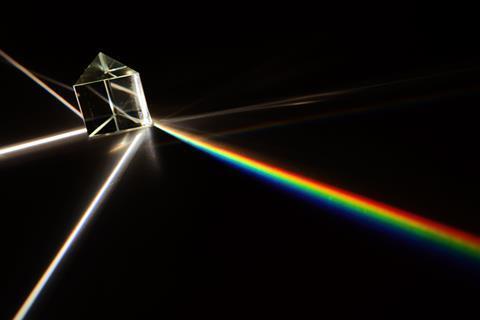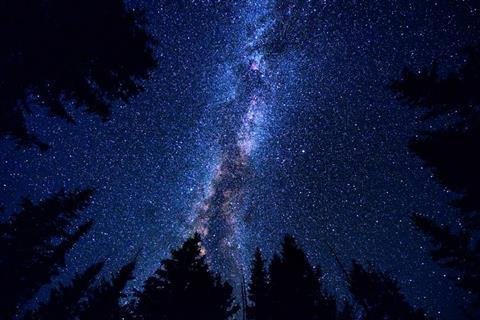Some of the most fascinating discoveries in chemistry have taken place among distant stars light years from Earth. By attaching spectrometers to a telescope, scientists can investigate the chemical cosmos, which may give clues to the origins of life on Earth

The key to understanding molecules in space lies in the electromagnetic spectrum. The 13th century philosopher and Franciscan friar Roger Bacon, also known as Doctor Mirabilis, was the first scientist to recognise that light, seemingly natural, white light from the Sun produces a rainbow of colours - red, orange, yellow, green, blue, indigo, and violet - through a glass of water. Centuries later, in 1671, Sir Isaac Newton gave this rainbow its modern name - the spectrum - after carrying out sophisticated experiments with sunlight and glass prisms, the basis of the spectrometer.
A couple of centuries later, physicists began to unravel the secrets of the visible spectrum and beyond. They recognised, for instance, that the spectrum represents a range of energies. (The absorbed energy, ΔE, is related to its frequency, ν, by the equation ΔE = hν, where h is the Planck constant, and the frequency of the absorbed or emitted energy is inversely proportional to its wavelength.) Red light has the least energy (lowest frequency, and longest wavelength) and violet has the most energy (highest frequency and shortest wavelength).
The visible spectrum, however, is only a very small part of the electromagnetic spectrum, with infrared, microwaves, and radio waves lying beyond the red end of the visible spectrum and have gradually lower energy. Ultraviolet, x-rays and gamma rays lie beyond violet and have increasing energy.
Star gazing
In the 19th century, scientists discovered that light from distant stars when viewed through a spectrometer does not produce a smooth spectrum, but rather a series of 'spectral lines', which are seen as bright or dark bands. The positions of these lines in the spectrum coincide with the absorption of energy by different atoms and molecules (and thus elements) in clouds of gas and dust lying between the stars and the observer on Earth. Each element has a characteristic spectral line. Indeed, the elements helium, thallium, and cerium were discovered on the basis of their spectral lines.
There are now several analytical techniques under the umbrella of spectroscopy that can reveal structural details of molecules using visible, infrared, or ultraviolet light. Shining the light through a sample and recording how much of the electromagnetic radiation is absorbed at different energies ( ie different frequencies or wavelengths) on a spectrometer, we can obtain information about an unknown compound in the sample.
Molecules absorb energy from incident light in different ways depending on their chemical structure, the strength of their bonds, the positions and mass of their atoms, and the angles between those atoms. Molecules vibrate, rotate, and bonds oscillate, depending on the absorbed radiation. Characteristic patterns of absorption are thus indicative not only of particular elements, but also of different bonds, or chemical groups or ions present in the sample.
Since it is impossible to collect a sample of cosmic dust from a distant nebula and bring it back to Earth for spectroscopic analysis, instead space chemists use the light from stars lying beyond the region of space they want to sample as the source of electromagnetic radiation. They use telescopes with spectrometers attached to record the spectrum of the material in the sample region.
Molecules abound
Over several decades, scientists have recorded the spectra of countless regions of space, identifying elements, and simple and almost ubiquitous small molecules such as hydrogen (H2), water (H2 O), methane (CH4), carbon monoxide (CO), nitric oxide (NO), aluminium monochloride (AlCl), iron oxide (FeO), and ammonia (NH3), hydrogen cyanide (HCN), carbonyl sulfide (OCS), isocyanic acid (HNCO), formaldehyde (H2 CO), ketene (H2 C2 O), silane (SiH4), ethanoic acid (CH3 COOH), dimethyl ether (CH3 OCH3), and benzene (C6 H6).
In all approximately 30 diatomic molecules have been observed, 31 triatomic molecules, 18 species with four atoms, and 65 small molecules with five or more atoms. There have since been hints that much more complicated molecules might be present in space and in recent years researchers have begun to gather evidence for the presence of such compounds.
In contrast, observers have found only rare examples of charged molecules in space. One of these, the hydronium ion (also known as protonated water, H3 O+), was first postulated by Herbst and Kemplere in 1973 who went on to identify the ion in 1986. The presence of such ions in space is significant in that it suggests that gas-phase reactions are taking place in interstellar space, with the formation of potentially complex molecules. The hydronium ion is now known to be abundant in the interstellar medium. It is found in diffuse and dense molecular clouds as well as the plasma tails of comets, such as Hale-Bopp.
In April 2008, scientists Arnaud Belloche at the Max Planck Institute for Radio Astronomy in Bonn, Germany, Robin Garrod of the department of astronomy, at Cornell University, US, and their colleagues, detected a relatively complex organic molecule, one that is closely related to the amino acids used by all living things on Earth to build proteins. This compound, amino acetonitrile (NH2 CH2 CN), was observed using a 30-metre radio telescope in Spain and two radio interferometers, a type of spectrometer, in France and Australia. The molecule is present in vast quantities in a giant cloud of gas near the centre of our Milky Way galaxy in the constellation of Sagittarius, known as 'Large Molecule Heimat'.
Finding such a molecule was an early hint of more complicated finds to come from the same team. In April this year, the scientists published details of the discovery of ethyl formate (C2 H5 OCHO) and n -propyl cyanide (C3 H7 CN) in the Large Molecule Heimat. These two compounds are more complex than amino acetonitrile and scientists speculate that an amino acid might also be present among the stars. Such a discovery, while expanding our understanding of how chemical reactions can take place in the rarefied clouds of gas and dust in space, would also suggest that amino acids might be more ubiquitous throughout the cosmos than we had thought.
Indeed, if amino acids are present in space, then some scientists have postulated that these molecules may have been carried to Earth from space through cometary or asteroid collisions during our planet's formative years. Conceivably, interstellar amino acids might have been the starting materials, the organic seeds for life on Earth billions of years ago. Scientists, however, have yet to find spectroscopic, or any other kind of conclusive evidence, for even the simplest amino acid, glycine (NH2 CH2 COOH), in the interstellar medium.
Star light

While finding complex molecules and, ultimately, amino acids in interstellar space has been the focus of many researchers for years, other scientists are looking at starlight to try and unravel the chemistry of the stars.
In 1985, chemist Harold Kroto had been attempting to understand the observed spectra of light from giant red stars and postulated that some of the characteristics of the spectra of these stars and the so-called diffuse interstellar bands (DIBs) might result from the presence of either very long chain-like carbon molecules or polycyclic aromatic hydrocarbons containing lots of carbon rings. Ultimately, Kroto's team working with colleagues in the US, suggested that an all-carbon molecule composed of 60 carbon atoms and shaped like a football made up of pentagons and hexagons might be the culprit. They went on to discover the molecule on Earth - buckminsterfullerene - but its existence in space remains elusive.
The most recent theory on the interstellar bands suggests that these might be down to element helium rather than any complex carbon molecule.
Originally published in InfoChem






No comments yet